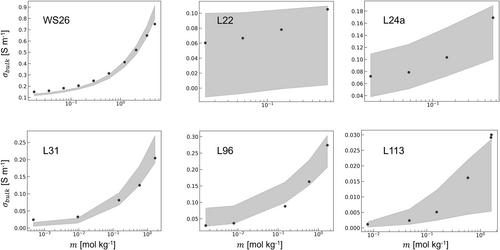Numerical Simulation on the Electrical Conductivity of Ternary Mixtures Containing NaCl Solution, Quartz, and Smectite
Abstract
While the electrical conductivity of smectite-rich rocks is high, previous studies have only partially revealed its dependence on temperature, salinity, and porosity. This knowledge gap mainly arises from challenges in controlling various experimental conditions when measuring the conductivity of real smectite-bearing rock samples and quantifying the smectite content. To mimic conductivity measurements under ideal conditions, this study aimed to develop a simulator capable of accurately configuring the conditions to predict the direct-current conductivity of saturated rocks composed of an aqueous NaCl solution, quartz, and smectite under various temperatures (20°C–200°C), salinities (10−4–5 mol kg−1), porosities (0–1), and smectite fractions (0–1). The simulator reproduced the experimental conductivity measurements from drilled core samples by giving the anisotropy of those components' distribution. In addition, simulations with randomly assigned components revealed that when rocks contain abundant smectite, the bulk conductivity partially decreases with increasing NaCl solution's salinity or volume fraction. These negative slopes were approximated using empirical equations derived from previous studies. Percolation analysis further revealed that when the components are randomly assigned, conductive paths begin to form between the ends of the modeled sample once the sum of the volume fraction of bulk pore and smectite reaches 0.1.


 求助内容:
求助内容: 应助结果提醒方式:
应助结果提醒方式:


